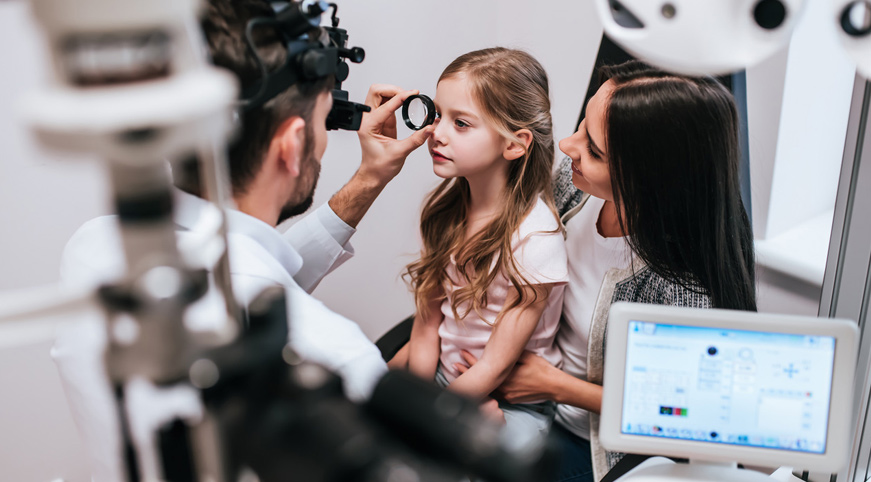Posted by Dr. Rohit Varma
Glaucoma is a leading cause of blindness in the United States and around the world1. More than 3 million people in the US are currently living with the condition, which often strikes with no symptoms until noticeable vision loss has occurred.
While glaucoma is widely considered to be a health concern primarily among older adults, the condition can also affect children. While rare, childhood glaucoma can dramatically alter a child’s life. Many parents are unfamiliar of the symptoms and causes of childhood glaucoma. An awareness of the condition in children can help parents and other family members protect children against the effects of the disease.
Primary Forms of Childhood Glaucoma
Childhood glaucoma is generally classified as one of three types based on the age of the child at the onset of the disease. They are:
- Congenital glaucoma, which occurs when an infant is born with the condition
- Infantile glaucoma, which occurs when a child develops the disease between the ages of one month old and 24 months old
- Juvenile glaucoma, which occurs when signs of the disease are found when a child reaches 3 years of age
These types of childhood glaucoma are categorized as either primary glaucoma, which results when doctors cannot identify a direct cause of the disease, or secondary glaucoma, which results when a child’s optic nerve is damaged as a side effect or as a direct result of another illness.
Childhood Glaucoma is Uncommon
Only about 1 in 10,000 infants are born with primary congenital glaucoma, in which the ocular drainage system within the eye develops abnormally before birth. However, the likelihood of contracting secondary glaucoma increases if a child is born with a condition such as aniridia, neurofibromatosis, Axenfeld-Rieger syndrome or had surgery to remove cataracts shortly after birth. Only 10 percent of cases of primary congenital glaucoma are caused by hereditary genetic mutations directly linked to the disease. However, children may inherit genes for the aforementioned illnesses that cause glaucoma, increasing the likelihood they will develop it.
Among toddlers and children older than 2 years of age, glaucoma affects approximately one in 2,000. Children in this age group tend to experience glaucoma as a secondary illness, rather than as a primary one.
Childhood Glaucoma can be Difficult to Recognize
As with the adult form of the disease, the symptoms of childhood glaucoma may not be noticeable. In cases of congenital glaucoma among infants, common symptoms may include excessive tearing, a tendency to squint or reflexively turn away from light sources, unusually large eyes or a cloudiness or “milky” appearance in one or both corneas. These same symptoms may also be present in cases of juvenile glaucoma. Older children may be able to describe symptoms that cannot be seen, but which may cause discomfort. They may include light sensitivity, frequent pain in the eyes or head, difficulty in adjusting to the dark, consistently red eyes, excessive squeezing of the eyelids or rapid blinking and vision loss. Children may also complain of feeling “something in the eye.”
An infant or child who demonstrates one or more of these symptoms should be taken to an ophthalmologist for an examination. Typically, the physician will check intraocular pressure levels in the children’s eyes using the tonometry method (a procedure to evaluate intraocular pressure) suited to the child’s unique situation. Parents are considered the “first line of defense” against vision loss in children with glaucoma, and any sign of struggling with their eyesight should be taken seriously and reviewed by a medical professional as soon as possible.
Treatment Options for Childhood Glaucoma
Treatment is crucial to prevent glaucoma from causing debilitating, lasting effects. If childhood glaucoma is diagnosed early and children receive the necessary treatment, it will not necessarily result in severe vision loss. However, it does generally require that children control the condition with appropriate medications and regular screenings throughout their lives. The Glaucoma Research Foundation encourages parents to remember that most children diagnosed with glaucoma can go on to lead full lives. In addition, the foundation emphasizes the importance of fostering a sense of independence in patients with glaucoma by involving them in their own care process.
Treatment is decided by a physician based on a number of factors, including a child’s age, relative health and history of medical issues. Physicians will also consider the severity of the disease, how the course of the disease is expected to progress, a child’s ability to tolerate certain procedures, medication, therapy options and the preferences of the parents. In general, a child with glaucoma will either be treated using oral medication or eye drops to either encourage the body to produce less fluid or to help the body drain fluid from the eye. Other options include conventional surgery, microsurgery or laser surgery, all of which can be used in different capacities to create an avenue for fluid to leave the eye and to relieve pressure. Many children are treated with a combination of medication and surgery, and a majority go on to retain a functional degree of vision.
1Glaucoma Research Foundation. Glaucoma Facts and Stats. Retrieved from https://www.glaucoma.org/glaucoma/glaucoma-facts-and-stats.php#targetText=Glaucoma%20is%20a%20leading%20cause,still%20experience%20loss%20of%20vision. Accessed [August 13, 2019]
Go to our Blog
 ENGLISH
ENGLISH KOREAN
KOREAN Spanish
Spanish RUSSIAN
RUSSIAN Armenian
Armenian FILIPINO
FILIPINO Chinese (Simplified)
Chinese (Simplified) Chinese (Traditional)
Chinese (Traditional)

최신댓글